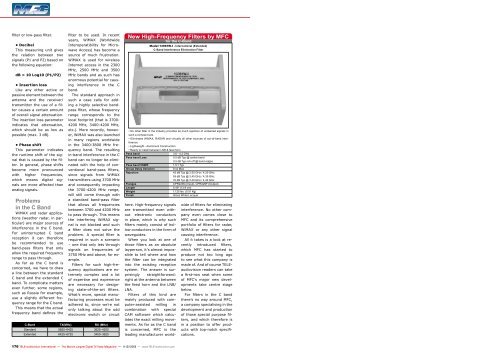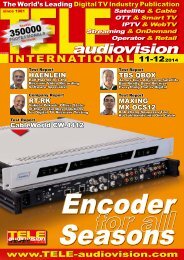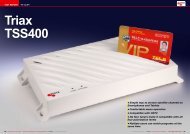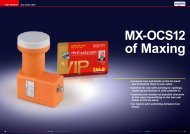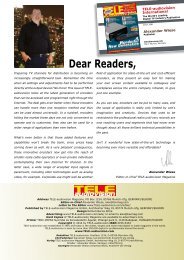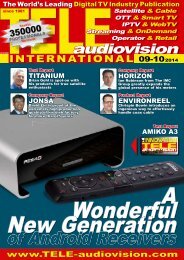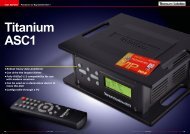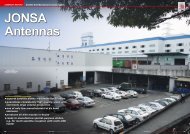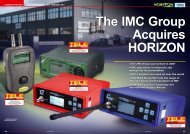Filters Made by MFC
You also want an ePaper? Increase the reach of your titles
YUMPU automatically turns print PDFs into web optimized ePapers that Google loves.
filter or low-pass filter.<br />
• Decibel<br />
This measuring unit gives<br />
the relation between two<br />
signals (P1 and P2) based on<br />
the following equation:<br />
dB = 10 Log10 (P1/P2)<br />
• Insertion loss<br />
Like any other active or<br />
passive element between the<br />
antenna and the receiver/<br />
transmitter the use of a filter<br />
causes a certain amount<br />
of overall signal attenuation.<br />
The insertion loss parameter<br />
indicates that attenuation,<br />
which should be as low as<br />
possible (max. 3 dB).<br />
• Phase shift<br />
This parameter indicates<br />
the runtime shift of the signal<br />
that is caused <strong>by</strong> the filter.<br />
In general, phase shifts<br />
become more pronounced<br />
with higher frequencies,<br />
which means digital signals<br />
are more affected than<br />
analog signals.<br />
Problems<br />
in the C Band<br />
WiMAX and radar applications<br />
(weather radar, in particular)<br />
are major sources of<br />
interference in the C band.<br />
For uninterrupted C band<br />
reception it can therefore<br />
be recommended to use<br />
band-pass filters that only<br />
allow the required frequency<br />
range to pass through.<br />
As far as the C band is<br />
concerned, we have to draw<br />
a line between the standard<br />
C band and the extended C<br />
band. To complicate matters<br />
even further, some regions,<br />
such as Russia for example,<br />
use a slightly different frequency<br />
range for the C band.<br />
This means that the actual<br />
frequency band defines the<br />
filter to be used. In recent<br />
years, WiMAX (Worldwide<br />
Interoperatibility for Microwave<br />
Access) has become a<br />
source of much frustration.<br />
WiMAX is used for wireless<br />
Internet access in the 2300<br />
MHz, 2500 MHz and 3500<br />
MHz bands and as such has<br />
enormous potential for causing<br />
interference in the C<br />
band.<br />
The standard approach in<br />
such a case calls for adding<br />
a highly selective bandpass<br />
filter, whose frequency<br />
range corresponds to the<br />
local footprint (that is 3700-<br />
4200 MHz, 3400-4200 MHz,<br />
etc.). More recently, however,<br />
WiMAX was also launched<br />
in many regions worldwide<br />
in the 3400-3800 MHz frequency<br />
band. The resulting<br />
in-band interference in the C<br />
band can no longer be eliminated<br />
with the help of conventional<br />
band-pass filters,<br />
since signals from WiMAX<br />
transmitters using 3700 MHz<br />
and consequently impacting<br />
the 3700-4200 MHz range,<br />
will still come through with<br />
a standard band-pass filter<br />
that allows all frequencies<br />
between 3700 and 4200 MHz<br />
to pass through. This means<br />
the interfering WiMAX signal<br />
is not blocked and such<br />
a filter does not solve the<br />
problem. A special filter is<br />
required in such a scenario<br />
– one that only lets through<br />
signals on frequencies of<br />
3750 MHz and above, for example.<br />
<strong>Filters</strong> for such high-frequency<br />
applications are extremely<br />
complex and a lot<br />
of expertise and experience<br />
are necessary for designing<br />
state-of-the-art filters.<br />
What’s more, special manufacturing<br />
processes must be<br />
adhered to, since we’re not<br />
only talking about the odd<br />
electronic switch or circuit<br />
C-Band TX(MHz) RX (MHz)<br />
Standard 5850–6425 3625–4200<br />
Extended 6425–6725 3400–3625<br />
New High-Frequency <strong>Filters</strong> <strong>by</strong> <strong>MFC</strong><br />
for the C-Band<br />
Model 13961W-I - International (Extended)<br />
C-Band Interference Elimination Filter<br />
• No other filter in the industry provides as much rejection of undesired signals in<br />
such a compact size.<br />
• Eliminates WiMAX, RADAR and virtually all other sources of out-of-band interference<br />
• Lightweight - Aluminium Construction<br />
• Ready to install between LNB & feed horn<br />
Pass band<br />
3.6 - 4.2 GHz<br />
Pass band Loss<br />
0.5 dB Typ @ centre band<br />
0.5 dB Typ roll-off @ band edges<br />
Pass band VSWR<br />
1.5:1 Typ<br />
Group Delay Variation<br />
8 ns Max<br />
Rejection<br />
45 dB Typ @ 3.55 GHz / 4.25 GHz<br />
55 dB Typ @ 3.45 GHz / 4.35 GHz<br />
70 dB Typ @ 3.40 GHz / 4.40 GHz<br />
Flanges<br />
CPR229G (Input), CPR229F (Output)<br />
Length<br />
5.49“ (13.9 cm)<br />
Weight<br />
1.125 lbs. (0.51 Kg)<br />
Finish<br />
Gloss White Lacquer<br />
here. High-frequency signals<br />
are transmitted even without<br />
electronic conductors<br />
in place, which is why such<br />
filters mainly consist of hollow<br />
conductors in the form of<br />
waveguides.<br />
When you look at one of<br />
those filters as an absolute<br />
layperson, it’s almost impossible<br />
to tell where and how<br />
the filter can be integrated<br />
into the existing reception<br />
system. The answer is surprisingly<br />
straightforward:<br />
right at the antenna between<br />
the feed horn and the LNB/<br />
LNA.<br />
<strong>Filters</strong> of this kind are<br />
mainly produced with computer-assisted<br />
milling in<br />
combination with special<br />
CAM software which calculates<br />
the exact milling movements.<br />
As far as the C band<br />
is concerned, <strong>MFC</strong> is the<br />
leading manufacturer worldwide<br />
of filters for eliminating<br />
interference. No other company<br />
even comes close to<br />
<strong>MFC</strong> and its comprehensive<br />
portfolio of filters for radar,<br />
WiMAX or any other signal<br />
causing interference.<br />
All it takes is a look at recently<br />
introduced filters,<br />
which <strong>MFC</strong> has started to<br />
produce not too long ago<br />
to see what this company is<br />
made of. And of course TELEaudiovision<br />
readers can take<br />
a first-row seat when some<br />
of <strong>MFC</strong>’s major new developments<br />
take centre stage<br />
below.<br />
For filters in the C band<br />
there’s no way around <strong>MFC</strong>,<br />
a company specialising in the<br />
development and production<br />
of those special purpose filters,<br />
and which therefore is<br />
in a position to offer products<br />
with top-notch specifications.<br />
176 TELE-audiovision International — The World‘s Largest Digital TV Trade Magazine — 11-12/2013 — www.TELE-audiovision.com


